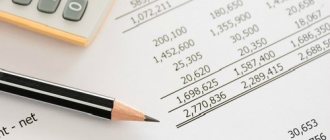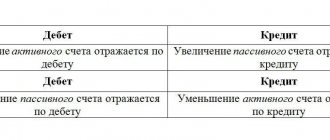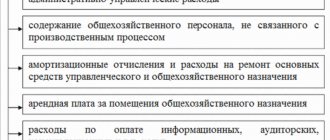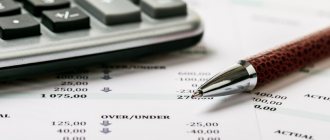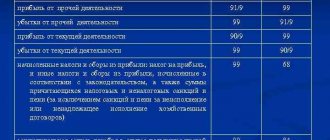In accounting, finished products from production are taken into account either at the actual production cost or at the planned (standard) cost. The actual sum is the sum of all costs associated with its production.
Planned or standard is the cost of production, based on the production cost standards established in the organization.
If finished products are accounted for at actual cost, then account 43 is used for accounting, but if planned or standard is used, then, as a rule, an additional account is entered. 40 “Release of finished products.”
Products released from main production: at what cost are they valued?
According to PBU 5/01 (approved by order of the Ministry of Finance of Russia dated 06/09/2001 No. 44n), finished products are part of the enterprise’s inventories (clause 2), and they must be reflected in accounting at the actual cost of production (clause 5). However, such a cost price for products produced during the month is not yet formed at the time of release, since the month of production has not ended, and the volume of product costs does not include those expenses that can only get there after the month closes. Moreover, these costs are not always indirect. For example, depreciation of fixed assets directly involved in the production of a certain type of product will also be accrued only after the end of the month.
Meanwhile, the production of products that are the main one for the enterprise is carried out continuously, and not only their release from production, but also shipment to customers can occur several times a month. Both manufactured and shipped products must be taken into account not only in quantitative terms, but also in cost terms (clause 203 of the Methodological Instructions, approved by Order of the Ministry of Finance of Russia dated December 28, 2001 No. 119n). At what cost is it assessed if data regarding the actual value of this indicator has not yet been compiled?
In this case, an interim assessment (accounting price) is applied, the possible options of which are cost (clause 204 of the Guidelines):
- normative;
- negotiated;
- any other.
At the end of the month, the result of the interim assessment must be adjusted to the actual values (clause 206 of the Guidelines). At the same time, it is allowed to continue to reflect products in the interim assessment, taking into account the formed deviations in a separate analytical article for this, and not for specific types of product, but for their groups (paragraphs 204-206 of the Guidelines).
Explanations for reporting
Each type of accounting report is accompanied by an explanatory note. It contains information:
- about the chosen method of accounting for fixed assets, inventory items;
- description of some balance sheet items (terms of debt repayment, rent payments, etc.);
- information about shareholders, capital structure;
- data on mergers, acquisitions, liquidations;
- off-balance sheet items.
Often an explanatory note provides more information about the financial position than statements. According to data from the balance sheet and f. No. 2 you can obtain information about the current state of affairs and performance efficiency. Having false information is worse than not having it. Therefore, it is important that financial statements are prepared correctly.
Unfortunately, even accountants make mistakes. The use of technical means allows you to avoid arithmetic errors, but not methodological ones. Also, reporting may be distorted due to the low skills of a specialist.
It is important to understand that the data in the balance sheet reflects the state of affairs at the reporting date. The very next day these indicators change. In the last weeks of the reporting period, the organization tries to defer payments, but in the first days of the new year, funds will be used to pay off the debt. Therefore, reporting is always done “with a reserve”. In the registers you can always find costs that will reduce the profitability indicator. For example, write off more inventory, non-current assets or bad debts. After all, it is always easier to lose profit than to increase it.
According to accounting rules, all transactions must be reflected at historical cost. But assets and liabilities arrive on the balance sheet at different periods of time. Therefore, on-balance sheet acquisition costs do not reflect the true value of the assets. You should also consider currency fluctuations if you have assets or liabilities denominated in foreign currencies.
Accounting for manufactured products at standard cost
What kind of wiring should be used to reflect the standard cost of manufactured products? For the posting carried out at the time of release - finished products are released from the main production - there are two options for its correspondence (the choice of these options is reflected in the accounting policy):
- with a direct correlation between the main production cost account (account 20) and account 43, intended for accounting for finished products;
- using an interim account 40, which operates only during the month and must be closed after its completion.
In the first case, the posting will look like Dt 43 Kt 20, and in the second - Dt 43 Kt 40. That is, in the first option, writing off during the month will lead to intermediate red balances on account 20. The second option does not affect account 20.
In any of the options, each type of created product at the standard cost (or other accounting price) and in the actual quantitative assessment will be reflected in account 43. In the case of shipment in the month of production, based on these indicators, the debit of account 90 will show the cost of products sold: Dt 90 Kt 43.
Unified form No. MX-18 - form and sample
Therefore, you need to create a write-off act form on your own or use a ready-made template.
For each object used in an activity, in one situation or another, it may be necessary to write it off, for example, into creation. Before you draw up an act for writing off a product, you should always do it accurately. The purpose of the portal is to collect and summarize, as well as analyze, all information posted on the Internet and in other sources related to documents.
If necessary, an act is drawn up with the role of a representative of sanitary or other supervision. In practice, there is an unlimited number of forms for accounting documents, such as reports, acts, income and expense books, certificates, expenses, cash books, receipts and almost everything else.
, , , ,
Next:
September 11, 2021
No comments yet!
Popular articles:
Latest materials:
Due to what actions will the products be reflected at actual cost?
Adjustment of the standard cost to the actual cost at the end of the month is carried out by writing off from account 20:
- On account 43 (if the intermediate account 40 is not used) - the magnitude of deviations (positive or negative) from the amounts already written off from account 20, which are divided as a percentage by the products sold during the month (due to their value, the cost of production included in the account is immediately adjusted 90) and for the remainder in the warehouse.
- On account 40 - the entire amount of actual costs incurred in creating products released during the month, which leads to the formation of both standard (credit) and actual (debit) costs on this account. The result of comparing the resulting figures gives the value of the deviations, which are also subject to distribution to the products sold (account 90) and products remaining in the warehouse (account 43).
An increase in actual cost compared to standard costs leads to the need to increase, due to deviations, the amounts shown on accounts 43 and 90, and this is reflected by direct postings to the amount of these deviations:
- Dt 43 Kt 20 and Dt 90 Kt 43 - if account 40 is not used in accounting transactions;
- Dt 43 Kt 40 and Dt 90 Kt 40 - if count 40 is used.
When the actual cost generated is lower than the standard cost, then exactly the same entries are applied to the deviations, but with a negative sign (reversing).
Thus, the posting—reflecting the actual cost of the finished product—regardless of which of the accounting correspondence options is used, is created by two operations:
- on calculating standard costs;
- for accounting for deviations.
The first of them is done at the time of release, and the second - after the close of the month.
Subaccounts
Account 43 has sub-accounts that agricultural and other agro-industrial enterprises can open. Among them:
- 43-1 “Products from the cultivation of cultivated agricultural plants”;
- 43-2 “Products from breeding farm animals for the production of livestock products”;
- 43-3 “Products manufactured by industrial and auxiliary industrial production”;
- 43-4 “Products manufactured by auxiliary, service, etc. production”;
- 43-5 “Products that have been accepted for sale to the public, household products.”
Important! It is worth noting that, depending on the subaccount, analytical accounting for the account is carried out by storage locations and individual types of products ready for sale.
Sub-accounts allow GPs to be divided into categories
Results
To reflect the receipt of finished products at the warehouse and their sale in the month of production (i.e. until data on the actual cost is generated), prices are used that reflect the interim assessment of the created product. After the month is closed, the interim estimate is adjusted to the actual estimate, and the cost of both the products shipped in the month of production and the products remaining in the warehouse are subject to such adjustment.
The formation of intermediate and actual costs in accounting can be carried out in two ways: without using account 40 and with its use.
In the first case, the intermediate cost and deviations from it (both positive and negative) are reflected by the posting Dt 43 Kt 20; at the same time, for deviations arising from shipped products, an additional write-off is made to account 90 (Dt 90 Kt 43). In the second case, the intermediate cost is fixed by posting Dt 43 Kt 40, and the actual cost - by posting Dt 40 Kt 20, i.e. the amount of deviations appears on account 40 and is credited from it to the shipped (Dt 90 Kt 40) and remaining in the warehouse (Dt 43 Kt 40) products. You can find more complete information on the topic in ConsultantPlus. Free trial access to the system for 2 days.
Sales profit - formula
How to calculate the value can be seen from the lines of Form 2 “Report on Financial Results”. Profit from sales is indicated on line 2200, broken down for the current year and the previous one. The formula looks like this:
Profit from sales (line 2200) = Gross profit (line 2100) – Selling expenses (line 2210) – Administrative expenses (line 2220).
Gross profit (line 2100) = Revenue (line 2110) – Selling cost (line 2120).
Note! When determining revenue, the values of VAT and excise taxes are not taken into account, since these taxes are reimbursable.
To fill out Form 2, information is taken from the enterprise’s accounting data for the reporting financial period. Usually this is a year, but if necessary, you can analyze indicators over time and for another time period - a month, half a year, quarter, 9 months. etc. What accounts will be needed? First of all, this is the account. 90 and 91. To clarify the information, the data of the corresponding accounts is analyzed - 62, 68, 44, 26, 23, 20, etc.
To accurately determine the required profit values, the main thing is to clearly understand which indicator needs to be calculated. To analyze the performance of the entire organization, a general calculation is performed, and to assess the success of individual divisions or activities, the data is broken down according to the required criteria.
How is profit reflected in the balance sheet? More on this later.
Balance sheet profit in reporting (form 2)
There are several types of profit on the income statement.
The following indicators exist:
- gross profit;
- profit (loss) from sales;
- profit (loss) before tax;
- Net income (loss).
As you can see, the concept of balance sheet profit is absent in the reporting (Form 2). The fact is that the balance sheet profit of an enterprise is a value that is considered a cumulative total from the beginning of the year. But it is not in the annual reports. The reason is the entries that the accountant makes at the end of the year and which reset certain accounting accounts. Therefore, we can say that the balance sheet profit of an enterprise is reflected in the reporting for the quarter, half a year and 9 months.
Formula for calculating gross profit:
Gross profit (line 2100) = Revenue (line 2110) - Cost (line 2120)
Line 2110 is a line in Form 2, which indicates revenue from the sale of products, goods, works, services. It is taken without value added tax and excise taxes.
Line 2120 shows the cost. That is, it includes expenses for ordinary activities.
To determine profit or loss from sales, calculate using the formula:
Profit (loss) from sales (line 2200) = Gross profit (line 2100) - Selling expenses (line 2210) - Administrative expenses (line 2220)
Line 2210 in the balance sheet is the amount of expenses from the ordinary activities of the organization. That is, this element of the formula is associated with the sale of goods, works, and services.
Line 2220 is all the costs that the company had and that are associated with managing the organization.
The calculation for profit before tax is as follows:
Profit (loss) before tax (line 2300) = profit (loss) from sales (line 2200) + Income from participation in other organizations (line 2310) + Interest receivable (line 2320) - Interest payable (line 2330) + Other income (line 2340) - Other expenses (line 2350)
To do this calculation, you must first complete lines 2310-2350 on your balance sheet income statement. Then we add the income to the figure of 2200, which was calculated earlier. Then we take into account expenses and get profit or loss. We look at the results in line 2300.
The formula for calculating balance sheet profit is as follows:
Balance sheet profit = line 2110 - line 2120 - line 2210 - line 2220 + line 2310 + line 2320 - line 2330 + line 2340 - line 2350
In annual reporting, balance sheet profit can be calculated as the sum of retained earnings from line 1370 and income taxes that the company must pay for the year.
Profit from sales in the balance sheet – line
Current financial reporting forms for enterprises were approved by the Ministry of Finance in Order No. 66n dated 07/02/10. This regulatory document introduced Form 1 (Balance Sheet), Form 2 (Report on Financial Results) and other additional annexes. It is impossible to say which specific line is profit from sales in the balance sheet, since the specified breakdown is provided in Form 2. It is here that the calculated values of gross, sales, net and other profits are indicated.
The balance sheet reflects the indicator of retained earnings (or uncovered loss) on page 1370 of Section III of the Liabilities. Consequently, from Form 2 you can see what the financial result of the enterprise is for a specific period, and from Form 1 - what is the accumulated result of activities for a given date. On page 1370 the account balance is indicated. 84, that is, minus the costs incurred by the company from profits (to create reserve capital, issue dividends, etc.). Thus, in order to accurately understand how profit from sales is generated, an accountant needs to analyze not only financial statements, but also accounting accounts - 90, 91, 99, cost accounts and others.
Financial and economic activities are reflected in the balance sheet of the enterprise. It represents the main form of reporting.
The balance sheet reflects:
- Profit;
- Lesion;
- Financial investments;
- Obligations.
According to its structure, it is divided into assets and liabilities. Financial result: profit or loss is reflected in the retained profit/uncovered loss account. Thus, it is incorrect to assume that the loss is reflected in the asset balance sheet. Let's look at the concepts in more detail.
It is legally established that all organizations are required to publish their balance sheet in the public domain. Thus, each counterparty registered on the government services portal has the opportunity to familiarize itself with the financial condition of the enterprise. Including seeing the amount of losses in the balance sheet..
Attention!
The loss in the balance sheet must be covered by summing up such indicators as profits from previous years, undistributed profits, funds in the reserve fund and target contributions. This is also possible through additional capital.
If, when adding such lines, the damage is not covered, therefore, there are not enough sources of financing. Thus, the balance is unprofitable. If the activity of the enterprise is positive, part of the profit goes into reserve. It acts as a “safety cushion” for future expenses. Accounts: Dt84-Kt82.
Products in the quality management system
From the point of view of the quality management system, products are the result of a process as a set of interrelated or interacting activities (GOST R ISO 9000-2008).
The quality management system distinguishes four general product categories:
- services (for example, transportation);
- software (for example, a computer program, a dictionary);
- technical means (for example, engine unit);
- recyclable materials (for example, lubricant).
Products may consist of items that fall into different general product categories. For example, a product such as a car includes technical means (engine, transmission, tires and many other technical elements), materials that are processed (gasoline, lubricant, coolant and others), software (software engine control, driver's instructions) and service (explanation of how to drive a car, after-sales (warranty) service)
Revenue and current assets
Information on current assets as of the reporting date is contained in the 2nd section of the balance sheet. In this section, the relationship between revenue and current assets can be traced primarily in the line “Cash and cash equivalents” - it is the company’s revenue that goes to the current account and cash desk.
A significant balance on this line as of the reporting date allows us to judge the methods and skills of managers to work with incoming revenue. For example, a company operates so profitably that it does not have time to immediately put the incoming revenue into new circulation in large volumes (purchase assets, make profitable investments, etc.). A low cash balance can equally indicate both the good work of financial managers, who are able to find the correct use of incoming revenue in a timely manner, and the company’s possible cash shortage.
IMPORTANT! If a company receives revenue at the cash desk, situations cannot be ruled out when the following limits may be exceeded:
- cash settlements between legal entities (directive of the Bank of Russia dated October 7, 2013 No. 3073-U);
- balance of cash in the cash desk (instruction of the Bank of Russia dated March 11, 2014 No. 3210-U).
Such violations may be punishable under Art. 15.1 Code of Administrative Offenses of the Russian Federation.
For more information about the rules that must be followed when working with cash proceeds, read the material “Cash discipline and responsibility for its violation”.
The connection between revenue and this balance sheet item can be traced in detail by studying another accounting report - the cash flow report. But the information from the balance sheet already makes you think.
How to calculate book profit: calculation formula
BP = Dod+ PD-Rod-PR
Basic elements of calculation:
- income from main activities (DoD);
- other income (PD);
- expenses from core activities (Gender);
- other expenses (PR).
If the calculation results result in a positive value, then the company made a profit for the period under review. A negative value indicates a loss.
If we subtract income tax (IP) from the resulting result, we obtain net profit (NP):
PE = BP-NP
Income includes:
- proceeds from sale;
- operating income;
- non-operating income.
However, the following is removed from income:
- amounts of taxes, such as VAT, excise taxes;
- sales tax and other taxes that apply to revenue;
- amounts that debtors transferred to you to repay loans and credits;
- prepayment amounts, advances;
- deposits and pledges;
- amounts collected under intermediary agreements to other individuals and companies.
Costs include:
- expenses for ordinary activities;
- operating expenses;
- non-operating costs.
Expenses do not include:
- acquisition and creation of fixed assets;
- acquisition of intangible assets and other non-current assets;
- contributions to the capital of other organizations;
- purchasing shares and other securities that are not intended to be resold in current transactions;
- transfers of funds under intermediary agreements;
- repayment of loans and borrowings;
- advance payment, advances issued, deposits towards payment.
BP analysis
So, book profit has been calculated. It is worth understanding what this indicator gives. It is used to analyze the financial and economic activities of an enterprise, ways of further development and factors that have a direct impact.
Advice: if at the end of the reporting period your balance sheet turns out to be unprofitable, reconsider the company’s operating policies.
Above we discussed the balance sheet lines, which reflect the income/loss of the enterprise. The goal of each manager is to reduce the balance sheet to a positive result at the end of the reporting period.
Activities to help the enterprise overcome losses and generate additional profit:
- Improving the quality of products;
- Increasing the volume of products produced;
- Equipment that is not used in production must be sold or leased;
- Optimization of the work process and the use of production resources, which will lead to a reduction in the cost of manufactured goods;
- Increasing sales markets;
- Reduced production costs;
- By increasing equipment capacity, increasing product output.
The “profit” indicator for an enterprise is the most important factor of production in a market economy. The goal of every commercial enterprise is to gain profit and increase it annually.
Main ways to increase profits:
- Reducing the cost per unit of goods;
- Revenue growth due to an increase in the volume of products.
Let's summarize. BP or loss helps determine how effectively the economic strategy of the enterprise was applied. The indicators that make up profit allow you to assess what should be emphasized in increasing it in the future reporting period. The main ways to increase profits are to reduce the cost of goods and increase production.
Revenue in the balance sheet - in which line can you see it? Most often, this question arises among accountants—newbies or those who are far from accounting. An experienced accountant will immediately say that there is simply no specific line in the balance sheet in which revenue is presented. And he will be right and wrong at the same time. Although there is no line with revenue in the balance sheet, revenue and the balance sheet are still interconnected. We will tell you exactly how in our article.
Revenue and 1st section of the balance sheet
Almost every line of the first section of the balance sheet is associated with a revenue indicator. For example, if the residual value of fixed assets or intangible assets decreased sharply during the reporting period, it is possible that some of them were sold. In this case, we can talk about the company’s possible revenue from their sale. If information appears on the balance sheet about profitable investments in material assets, you can expect to receive revenue from an activity such as renting out property.
In the 1st section there are lines that, it would seem, have no connection at all with revenue, for example, financial investments. But it is not so. If a company operates profitably and is interested in its development, it will try to increase the money it earns. Financial investments are one such way. Of course, it is also possible to purchase securities or make contributions to the authorized capitals of other companies using borrowed funds. However, the main source in sustainable developing companies is profit, a significant part of which is revenue.


